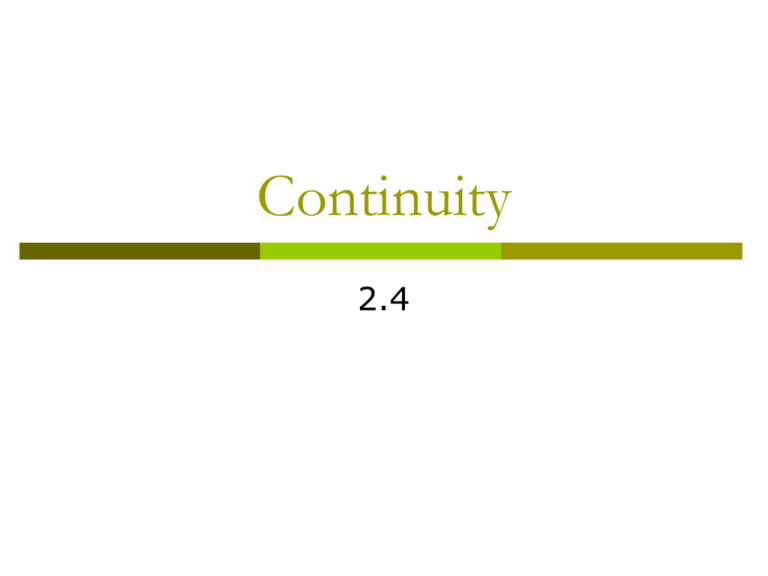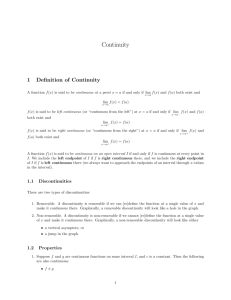Continuity
advertisement

Continuity 2.4 Most of the techniques of calculus require that functions be continuous. A function is continuous if you can draw it in one motion without picking up your pencil. A function is continuous at a point if the limit is the same as the value of the function. This function has discontinuities at x=1 and x=2. 2 1 1 2 3 4 It is still considered continuous at x=0 and x=4, because the one-sided limits match the value of the function Continuity Continuity TEST (MEMORIZE!) Show g ( x) x 2 1 is continuous at x = 1 1. g (1) exists. [ g (1) 2] 2. lim g ( x)exists. [lim g ( x) 2] x 1 x 1 3. lim g ( x) g (1) 2 x 1 g ( x) is continuous at x 1 x 1 x 2 Show the function f(x) continuous at x 2? 2x - 1 x 2 1. f (2) exists. [ f (2) 3] 2. lim f ( x) (2) 1 3 x 2 lim f ( x) 2(2) 1 3 x 2 lim f ( x) exists 3 x 2 3. lim f ( x) f (2) 3 x2 f ( x) is continuous at x 2 Key locations to test for continuity Rational Expression Piecewise Functions Changes in interval Absolute Value Functions Values that make denominator = 0 Use piecewise definition and test changes in interval Step Functions Test jumps at each step. Types of Discontinuities There are 3 types of discontinuities Jump Infinite (Asymptotic) Point The first two are considered non-removable. Point discontinuity is often referred to as a removable discontinuity since we can make the function continuous if we alter our function at the location of the hole. Jump Discontinuity Occurs when the graph breaks at a particular point and starts somewhere else Left hand limit does not equal Right hand limit lim f ( x) lim f ( x) x c x c Infinite (Asymptotic) Discontinuity Occurs when curve has a vertical asymptote. Continuity does not exist due to asymptote! Point Discontinuity Can occur when you have a rational expression with common factors in the numerator and denominator. Can occur when the curve has a “hole” because the function has a value that is off the curve at that point. This will result when lim f ( x) f (c) x c Identify the discontinuity on the graph and state whether it is removable. Find and identify the discontinuity. x 3 x 2 f(x) 2 x2 x 1. f (2) 5 2. lim f ( x) 5 x2 lim f ( x) 4 x2 lim f ( x) DNE x2 Jump discontinuity (non-removable) Find and identify the discontinuity. 5 f ( x) x4 Infinite discontinuity (non-removable) (VA at x = 4) Find and identify the discontinuity. x 8 x 15 f ( x) 2 x 6x 5 2 x 5x 3 f ( x) x 5x 1 2 Types of Discontinuity Point discontinuity (removable) at x=5. [Hole at (5,.5)] Infinite discontinuity (non-removable) at x=1. (VA) Find and identify the discontinuity 5 f(x) 2 x x2 x2 1. f (2) 5 2. lim f ( x) 4 x2 lim f ( x) 4 x2 3. lim f ( x) f (2) x 2 lim f ( x) 4 x2 Point discontinuity (removable) For what value(s) of a is the function continuous at 4? ax 5 x 4 f ( x) 2 x x x 4 Test for continuity at 4 1. Does f(4) exist? f(4) 42 4 12 2. lim f ( x) lim f ( x) 12 x4 x 4 So set ax + 5 = 12, a(4)+5=12 This value automatically satisfies 3rd condition! 7 a 4 Determine the constant c, so the function is continuous everywhere. cx 1, x 3 f ( x) 2 cx 1, x 3 2. lim f ( x) lim f ( x) x 3 x 3 c(3) 1 c(3) 2 1 3c 1 9c 1 2 6c 1 c 3 Test for continuity at 3! Continuity : (Check ) 1 1. f (3) (3) 1 2 3 2. lim f ( x) lim f ( x) x 3 x 3 1 1 2 (3) 1 (3) 1 3 3 22 This ensures the 3rd condition is satisfied! Intermediate Value Theorem 2.4 cont. Simple examples: If between 7am and 2pm the temperature went from 55 to 70. At some time it reached 62. Time is continuous If between his 14th and 15th birthday, a boy went from 150 to 165 lbs. At some point he weighed 155lbs. It may have occurred more than once. Show that a “c” exists such that f(c)=2 for f ( x) x 2 2 x 3 in the interval [0, 2] f(x) is continuous on the interval f(0)= -3 f(2)= 5 By the IVT, there must be y-value of 2 since f is a polynomial (continuous) and the y-values are in the range from [-3,5]. Determine if f(x) has any real roots on the stated interval: f ( x) x x 1 on [1,2] 2 f(x) is continuous on the interval f (1) 1 2 -.414 f (2) 4 3 2.268 By the IVT, there must be a real root between x=1 and x=2 where f(c)=0 because f is continuous and 0 is between f(1) and f(2). What you will write: By the IVT, there exists a value (x=c) between [1,2] where f(c)=0.








